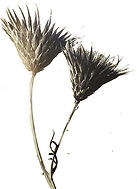Jean Corby
Artist
A contemporary nature artist combining paint and thread
to create visual celebrations of our natural environment.

Nature is messy, wild, unpredictable, uncontrollable. She is birth, life, death, fire and ice, beauty and decay. Her vastness both terrifies and sooths us. She is our mother, our teacher, our healer, our grave. We are born to her and to her we will return. Jean Corby has a reverence for nature that compells her to make art. Using her own contemporary visual language, she endeavors to express nature's transcendent revelations in each thread painting she creates. As a contemporary nature artist, she leaves realism to others and interprets nature scenes in a mixed media that combines paint and machine embroidery for a new and modern textile art. With broad swaths of embroidered texture and overlapping colors, she invites the viewer to experience the natural beauty and mystery that she sees and feels. To capture the energy and mood of a nature scene, Jean Corby starts by applying loose brush strokes of watery paint to a canvas. She envisions the plant growth that will emerge in thread on top of the paint adding contrast and detail to refine the story. Thread is the preferred material to illustrate the unruly wild growth of wildflowers and native plants for this contempoary nature artist. By often leaving threads untrimmed after completing an embroidery, the impression of untamed plant growth is complete. After years of experimentation, Jean Corby's mixed media technique has coalesced so that painted surfaces and embroidered areas are complimentary as well as expressive. Some might think that native wildflowers are inferior to the manicured gardens and hybridized specimens that wow us but contemporary nature artists know that wildlife and wildflowers are essential to growth and balance in the environment. Jean Corby sees the special beauty of wild plants as did Karl Blossfeldt, the 19th century photographer who glorified the functional beauty of his plant subjects in magnified black and white photos. His images reveal the intricate order that lies hidden behind the overt "homeliness" of wild plants. Like Blossfeldt, it is the unconventional beauty of the untamed that interests Jean Corby. Wild plant growth is actually anything but. On the contrary, it's cellular operations are highly organized and democratic where form follows function and all natural laws are obeyed. In her work, Jean Corby gives a nod to traditional stitchery by selecting from a library of preset digitized patterns to fill abstract shapes in her thread paintings. The contrast of tiny embossed flowers or leaves in perfect orderly rows inside the lines of irregular shapes is a visual pun. Corby is saying; "I use the order and predictability of pattern as a tool to defy traditional rules of order for freedom of expression". Corby makes use of technology only to edify her painterly style in her contemporary thread paintings of nature. With each mixed media art piece, Jean Corby wants us to remember the line from the song, "Big Yellow Taxi" by Joni Mitchell. "They paved paradise and put up a parking lot." Unconscious unchecked land development robs our planet of places where nature is free to experiment. Wherever plants grow be it farmland, forest, field, meadow, garden , lawn, sidewalk, marsh, backyard, mountain, et al., the cultivated and the native plant life of earth work together to keep us all alive and nurtured. Jean Corby, contemporary nature artist, believes the sharing and teaching of nature's glory and preservation thereof, are nobile endeavors that can never cease. In the words of the famous nature painter, Georgia O'Keefe, "To see takes time". Corby would add that understanding takes time too.



FOR THE LOVE OF WEEDS
Many of Jean Corby's thread paintings include embroidered depictions of weeds or native plants. Weeds are often regarded as a nuisance in gardens, but they can actually be of great value to the environment. Weeds act as natural mulch, helping to retain moisture and keep soil healthy. They provide shelter and food for beneficial insects, such as bees and butterflies, and also serve as a habitat for small animals. Weeds also help to prevent soil erosion due to their extensive root systems. Additionally, some roots can even be eaten or used in medicinal treatments. By creating depictions of native plants in her mixed media art work, Jean Corby hopes to bring attention to this overlooked plant group that never the less, helps to create a healthier more biodiverse environment.



